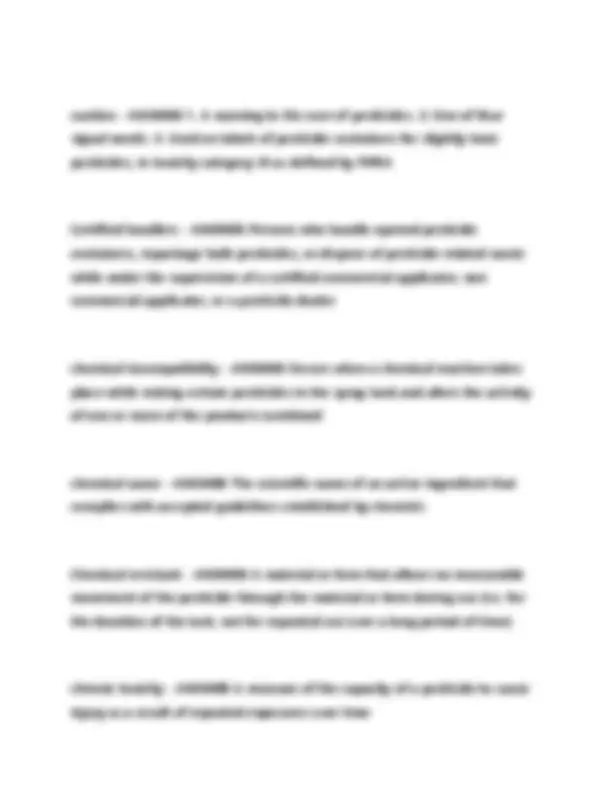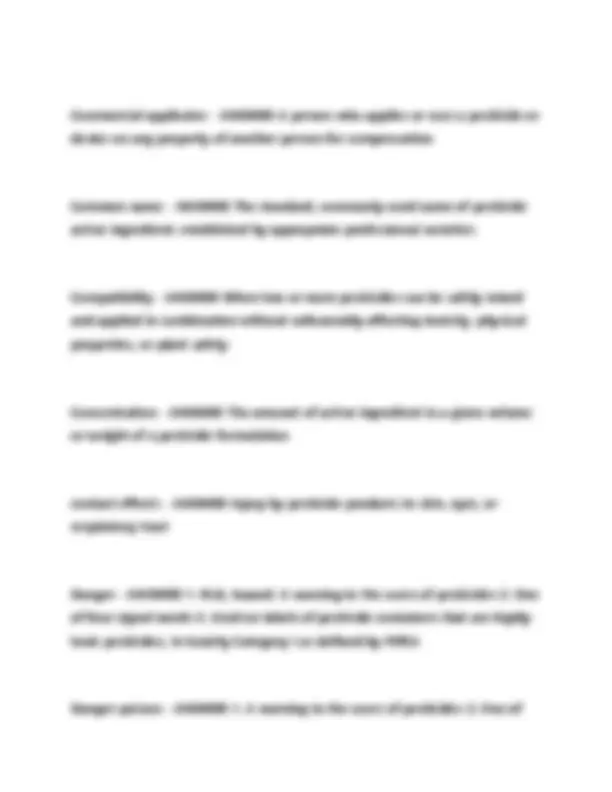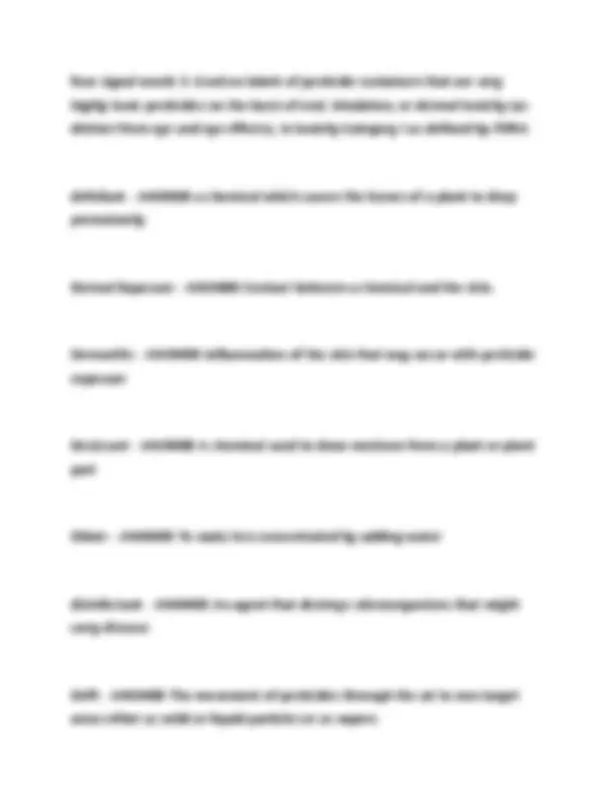






Study with the several resources on Docsity

Earn points by helping other students or get them with a premium plan


Prepare for your exams
Study with the several resources on Docsity

Earn points to download
Earn points by helping other students or get them with a premium plan
Community
Ask the community for help and clear up your study doubts
Discover the best universities in your country according to Docsity users
Free resources
Download our free guides on studying techniques, anxiety management strategies, and thesis advice from Docsity tutors
Iowa Certified Handler Manual Test With Complete Solution.
Typology: Exams
1 / 8

This page cannot be seen from the preview
Don't miss anything!





Acaracide - ANSWER A pesticide used to control mites and ticks
active ingredient - ANSWER A component of pesticide product that has pesticide activity; normally mixed with inert ingredients in the formulation process
acute toxicity - ANSWER A measure of the capacity of a pesticide to cause injury as a result of a single exposure
Adjuvant - ANSWER A chemical added to a pesticide formulation to increase its effectiveness or safety
Agitation - ANSWER The process of stirring or mixing in a sprayer
Agitator - ANSWER A mechanical or hydraulic action to keep a pesticide mixed in the solution of spray tank
Antidote - ANSWER A substance used to counteract pesticide poisoning
Antimicrobial - ANSWER Substances or mixtures of substances used to destroy or suppress the growth of harmful bacteria, viruses, or fungi on inanimate objects and surfaces
Apiaries - ANSWER A group of hives or colonies of bees kept for honey production and/or pollination of crops
Application rate - ANSWER The amount of pesticide applied to a site; usually expressed as a liquid or dry measure per unit area.
Avicide - ANSWER A pesticide used to repel or control birds
Back-siphoning - ANSWER The reverse flow of water resulting from a reduction in water pressure
bactericide - ANSWER A chemical used to control bacteria
Boom - ANSWER A section of pipe or tubing that connects to several nozzles so that a pesticide can be applied over a wider area
Brand name - ANSWER The specific, registered name given by a manufacturer to a pesticide product; same as a trade name or proprietary name.
Bulk pesticide - ANSWER Pesticides that are packaged in greater than 55 gallons or 100 pounds dry weight containers
Carrier - ANSWER The liquid (usually water, lightweight oil, or fertilizer) material that a pesticide is added to for application
Commercial applicator - ANSWER A person who applies or uses a pesticide or device on any property of another person for compensation
Common name - ANSWER The standard, commonly used name of pesticide active ingredient; established by appropriate professional societies
Compatibility - ANSWER When two or more pesticides can be safely mixed and applied in combination without unfavorably affecting toxicity, physical properties, or plant safety
Concentration - ANSWER The amount of active ingredient in a given volume or weight of a pesticide formulation
contact effects - ANSWER Injury by pesticide products to skin, eyes, or respiratory tract
Danger - ANSWER 1. Risk, hazard. A warning to the users of pesticides 2. One of four signal words 3. Used on labels of pesticide containers that are highly toxic pesticides, in toxicity Category I as defined by FIFRA
Danger-poison - ANSWER 1. A warning to the users of pesticides 2. One of
four signal words 3. Used on labels of pesticide containers that are very highly toxic pesticides on the basis of oral, inhalation, or dermal toxicity (as distinct from eye and eye effects), in toxicity Category I as defined by FIFRA
defoliant - ANSWER a chemical which causes the leaves of a plant to drop prematurely
Dermal Exposure - ANSWER Contact between a chemical and the skin.
Dermatitis - ANSWER inflammation of the skin that may occur with pesticide exposure
Desiccant - ANSWER A chemical used to draw moisture from a plant or plant part
Dilute - ANSWER To make less concentrated by adding water
disinfectant - ANSWER An agent that destroys microorganisms that might carry disease
Drift - ANSWER The movement of pesticides through the air to non target areas either as solid or liquid particles or as vapors
Fit check - ANSWER On the spot check to ensure that a respirator is working correctly
Fit Test - ANSWER A check to see if a respirator fits properly to provide protection against pesticide exposure
Flowable (F or L) - ANSWER A pesticide formulation in which the active ingredient is impregnated on a diluent such as clay that is then finely ground and suspended in a small amount of liquid; the resulting cream like formulation is added to water in the spray tank and forms a suspension
formulation - ANSWER The pesticide product as end product, usually consisting of a mixture of active and inert ingredients
fungicide - ANSWER a chemical used to control fungi
growth regulator - ANSWER Substances (other than fertilizers or food) that alter the growth or development of a plant or animal
hazard - ANSWER The potential for pesticide injury under a given set of circumstances; it reflects both the toxicity of the pesticide and the likelihood
that significant exposure will occur in a particular situation
hazardous waste - ANSWER A solid, liquid, or a contained gaseous material that no longer serves the purpose for which